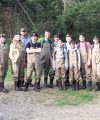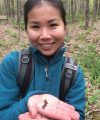EEB 3266: Field Herpetology
May Term, 2017
May 8th – May 26th
Monday through Friday, 9:00am – 12:00pm in TLS 179
Depending on weather conditions some classes will be held at night 7:00pm – 10:00pm instead, allowing us to observe nocturnal amphibians.
Official Syllabus
Field Photo Gallery!
Frog Call MP3 Files
Final Exam Guide
Course Schedule
| Date | Lecture | Tentative Field Agenda | Additional Materials |
| May 8 | Lecture 1 – Introduction, Syllabus, Field Notebooks, IACUC Training | UConn Forest Fenton Tract, Red and Green Trails | -Pough, Chapter 1
– Miller 1942, Field Notebook Guidelines (pg. 4-5 most important) |
| May 9 | Lecture 2 – Salamanders of Connecticut | UConn Forest Fenton Tract, Fenton River and Fenton River Meadow | – Pough, Chapter 2 – Pough, Chapter 3 – Some reference research questions |
| May 10 | RESEARCH QUESTIONS DUE (9 am) Lecture 3 – Frogs and Turtles of Connecticut |
Hillside Environmental Education Park (HEEP) | – Pough, Chapter 2 – Pough, Chapter 3 – Pough, Chapter 4 |
| May 11 | HYPOTHESES DUE (9 am) Lecture 4 – Squamates of Connecticut |
Mansfield Hollow | – Pough, Chapter 4 |
| May 12 | FIELD NOTEBOOKS DUE (9 am) RESEARCH PROPOSAL DUE (5 pm) Lecture 5 – Habitats and Field Techniques |
Albert E. Moss Sanctuary
|
– Bennet, Expedition Field Techniques for Reptiles and Amphibians |
| May 15 | Lecture 6 – Physiology | UConn Forest North Eagleville Tract, Bonemill Pond | – Pough, Chapter 6 – Pough, Chapter 7 |
| May 16 | DRAFT INTRODUCTION DUE (9 am) Field Research Day |
NIGHT TRIP
UConn Forest Fenton Tract, Fenton River and Fenton River Meadow |
|
| May 17 | DRAFT METHODS DUE (9 am) Lecture 7 – Locomotion |
UConn Forest Moss Tract (“the Dusky site”) | – Pough, Chapter 10 |
| May 18 | Field Research Day | Bigelow Hollow | |
| May 19 | FIELD NOTEBOOKS DUE (9 am) DRAFT RESULTS DUE (5 pm) Lecture 8 – Feeding |
Sawmill Brook Preserve | – Pough, Chapter 11 |
| May 22 | Lecture 9 – Behavior and Reproduction | TBD | – Pough, Chapter 8 – Pough, Chapter 9 – Pough, Chapter 13 – Pough, Chapter 14 |
| May 23 | DRAFT DISCUSSION DUE (9 am) Field Research Day |
TBD | |
| May 24 | Lecture 10 – Conservation | TBD | – Pough, Chapter 17 |
| May 25 | FINAL EXAM | Optional Field Excursion TBD | |
| May 26 | FIELD NOTEBOOKS DUE PAPERS DUE PRESENTATIONS |
About the Instructor
Andrew Frank
Email: andrew.frank@uconn.edu
Office: Biology/Pharmacy 322
Phone: (845) 728-6551
Office hours: by appointment, often right after class.
Course Description and Objectives
Course Description
Herpetology is the scientific study of the amphibians and reptiles. In this course, we will examine the diversity of both groups, and learn about their basic biology. Students will learn about the diversity, ecology, physiology, behavior, adaptation and identification of the local herpetofauna through direct field experience. There will be various opportunities to observe these animals in the field during the day and at night, through which students will become familiar with standard methods for surveying for and handling these species. Students will apply this knowledge by developing and carrying out a short independent research project.
Course Objectives
After completing this course the student will be able to:
- Identify Connecticut’s amphibians and reptiles by sight, and in the case of frogs by sound as well.
- Describe the biology of local herpetofaunal species and their corresponding families
- Effectively use standard field techniques and methods for studying herpetofauna
- Apply with proficiency the scientific method to assess questions and design and carry out a project pertaining to herpetofaunal biology.
Assignments
Project
Students will formulate and carry out an instructor-approved group research project using local Connecticut herpetofauna. Students are expected to identify a research question, develop a hypothesis, and test this hypothesis using field methods learned in class.
- As the semester progresses, students will independently prepare small assignments and drafts designed to guide students when preparing to write their full research report. Guidelines for these assignments will be detailed during lecture.
- At the end of the semester, students will independently prepare a final report about their research project (5-7 pages, double spaced, 12 pt Times New Roman font, 1 inch margins), including relevant background information, the materials and methods used, results of the experiment, results of any data analysis performed, and a discussion of the results.
- At the end of the semester, students will prepare a 15-minute presentation about their project, and present on the final day of class.
- Students may work on the project independently, or with a partner. NOTE: Student who choose to work with a partner are required to submit separate and original project drafts and final reports, but may give their presentation to the class together.
- Both the paper and presentation will be graded on content, quality, and clarity.
Final Exam
The final exam will be composed of short-answer questions based on Connecticut herpetofauna identification (both written descriptions and identification of preserved specimens), the natural history of Connecticut herpetofauna, predicting occupancy of particular habitat types, field techniques, and lecture content.
Field Notebooks
Students are expected to keep a formal notebook for observations of Connecticut herpetofauna in the field. Field notebooks will be graded based on format (we will use the Grinnellian field notebook system), completeness, degree of detail in observations, and relevancy of details noted. Notebooks will be collected and graded at the end of each week.
Course Procedures and Policies
Grades
- Paper on project: 150 pts total
- Iterative Drafts: 50 pts
- Proposed research questions
- Proposed hypotheses
- Full research proposal
- Drafts of: introduction, methods, results, and discussion
- Final Paper: 100 pts
- Iterative Drafts: 50 pts
- Presentation on project: 50 pts
- Final: 100 pts
- Field notebook entries: 75 pts
- Participation: 25 pts
- TOTAL: 400 pts
Attendance
Due to the accelerated and intensive nature of this summer course (3 hours, 5 days a week, 3 weeks), full attendance is expected, barring any illnesses or emergency. Missing a single class is roughly the equivalent of missing an entire week of a course during a standard semester, so it’s very important that you attend every class.
Academic Integrity
Plagiarism and cheating are violations of the student conduct code, and may be punished by failure in the course or, in severe cases, dismissal from the University. For more information, see Appendix A of the Student Conduct Code.
Disabilities
If you have a disability for which you may be requesting an accommodation, you should contact the course instructor and the Center for Students with Disabilities (Wilbur Cross Building, Room 201) on the first day of the semester.
Course Materials
Required
- A Field Guide to Reptiles and Amphibians of Eastern and Central North America 4th edition; R. Conant and J. Collins ISBN-10: 0395904528
- Field Notebook – Bound field notebook (composition book is fine and cheap, or the “Rite in the Rain” notebooks)
- Clothes you are willing to ruin
Recommended
- Herpetology, 4th Edition; Pough, Andrews, Crump, Savitzsky, Wells, and Brandley ISBN-10: 1605352330
- Boots
- Waders (Will be provided if you don’t have any)
- Headlamp (Will be provided if you don’t have one)
- Sunscreen
- Bug spray
- Electronics dry bag
Previous Courses






